Watch Dogs Review
When Ubisoft first revealed Watch Dogs back at E3 2012, it was regarded as one of the biggest surprises of the show. A unique concept, a slick gameplay teaser, and a narrative theme that’s highly relevant to today’s interconnected world. Although much time has passed between the reveal and the game arriving in stores today, Watch Dogs has managed to retain much of the promise it offered at the outset. A detailed open world experience with unique moment to moment gameplay, combined with some familiar Ubisoft style of missions and engaging multiplayer, makes this a worthwhile title for any stealth-action fans.
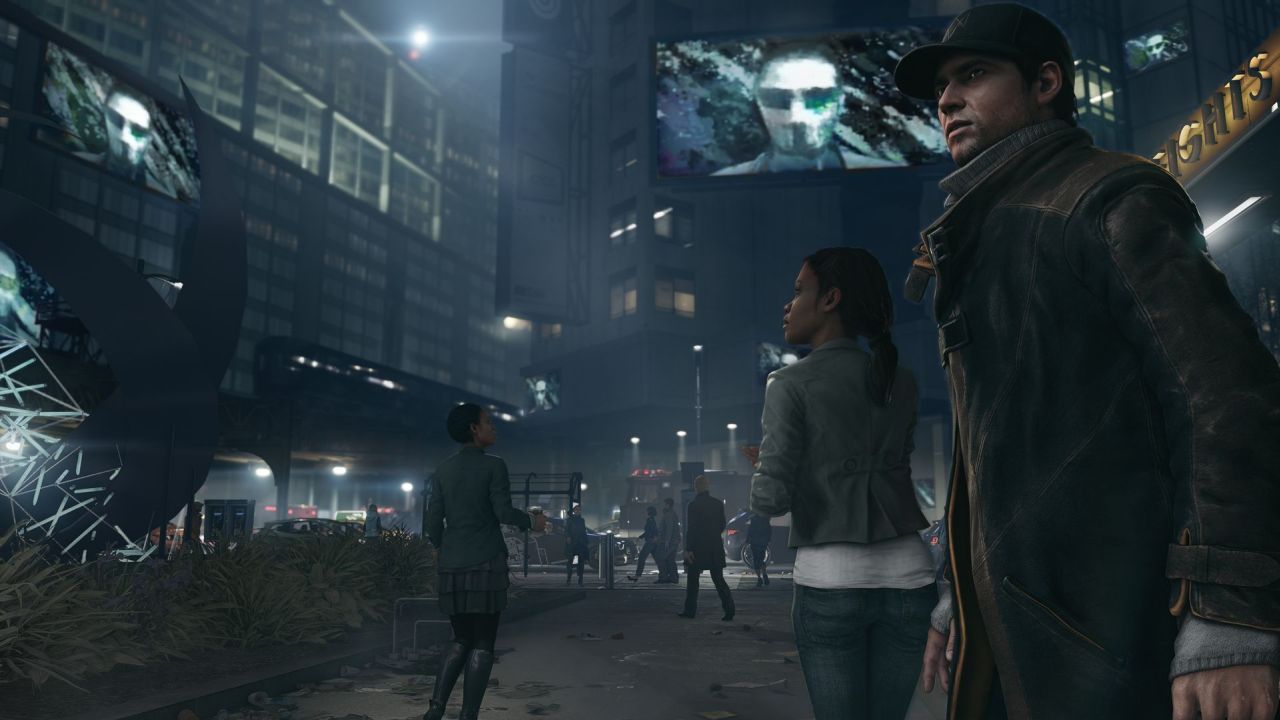
Players assume the role of Aiden Pearce, a man that’s proficient in hand to hand combat as well as using his smartphone to hack into almost any electronic device around him. He is the man in the field, scouting out banks and potential heist targets, while being assisted remotely by a colleague behind a PC. When one such heist goes wrong, Aiden ends up in the crosshairs of an unknown organization that orders he be pushed out of the hacking business with threats. During this event, however, Aiden’s niece is killed, and our protagonist takes almost a year to track down the man who attacked them. Upon confronting him, we learn that the conspiracy runs deeper than expected, and Aiden makes it his goal to track down all those responsible.
We also get to meet Aiden’s sister and her son, who have a rocky relationship with him, given Aiden’s apparent inability to let go of the accident. It is alluded to that his actions have put this small family in danger, and it doesn’t take long until Aiden’s sister does indeed get tangled up in the underworld because of his actions. To help resolve the situation, and keep his hacking abilities operational, Aiden involves the secret hacking collective called DedSec and gets to meet its various members. The group acts as a rebellious organization against ctOS and most authority in general.
The narrative starts out slow and rather cliché, and Aiden as a character is not well developed. He comes across as a wannabe Batman, with same growly voice, a man troubled by the way of the world. The game attempts to present him as a vigilante, but such themes fall flat after you take out just as many people and police as a regular day in Grand Theft Auto, not to mention freely steal from people’s bank accounts. Still, as the plot develops players will become engrossed in the overall conspiracy taking place and will want to see out the fates of Aiden and Co. When the plot focuses less on the failed attempts of family drama and ramps up the intensity of underground hacking culture, the game really takes off and ends up being a worthwhile tale of betrayal and revenge that runs deeper than players will expect.
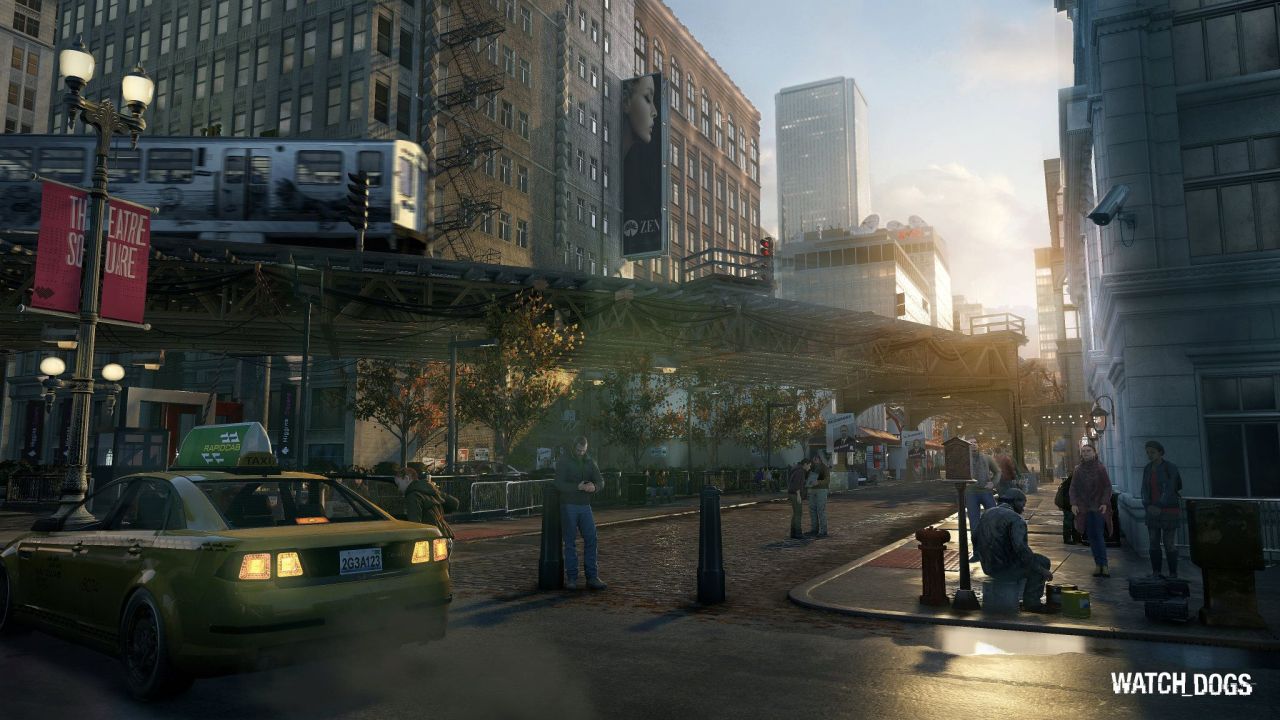
Over the course of the 5-act, 40+ mission campaign, you’ll get to explore a slightly futuristic version of the city of Chicago. The developers have spared no effort to ensure that the urban environments are recreated with great attention to detail, from landmarks to lesser known locales. There is a full day and night cycle that runs continuously and adds that much more atmosphere to the setting. Exploring the downtown at night, the sleepy suburbs on a sunny evening, or the run down parts of town on a rainy morning gives off totally different vibes. The citizens go about their lives, have conversations, and help complete this believably alive version of Chicago.
Everything in Chicago is connected to the Central Operating System (ctOS), and it controls almost every piece of the city’s technology. This plays into the central hacking gameplay of Watch Dogs, but also adds to the setting. By simply pulling out the smartphone, Aiden gets a glimpse into the life of every NPC citizen that is near him by instantly offering a profile with bits of info like their name, photo, occupation, or a secret of their life. Most of the time, profiling is a purely visual feature, but one that adds to the immersion of this game world. Some NPCs’ devices can be hacked, and the results range from stealing their bank info, to stealing a new piece of music, to uncovering a potential crime or side missions.
Most of the campaign missions follow a relatively familiar structure for an open world title, tasking players with reaching a certain location or finding a character, escaping chases, and so forth. Many missions are focused on stealth, and that’s where Watch Dogs feels most rewarding and fun. Players who are familiar with Ubisoft titles will instantly recognize the structure of the infiltration missions – where an area in the open world is deemed as restricted and filled with foes who will shoot on sight if they see Aiden within the limits. Your task is usually to enter and reach the objective within this zone.
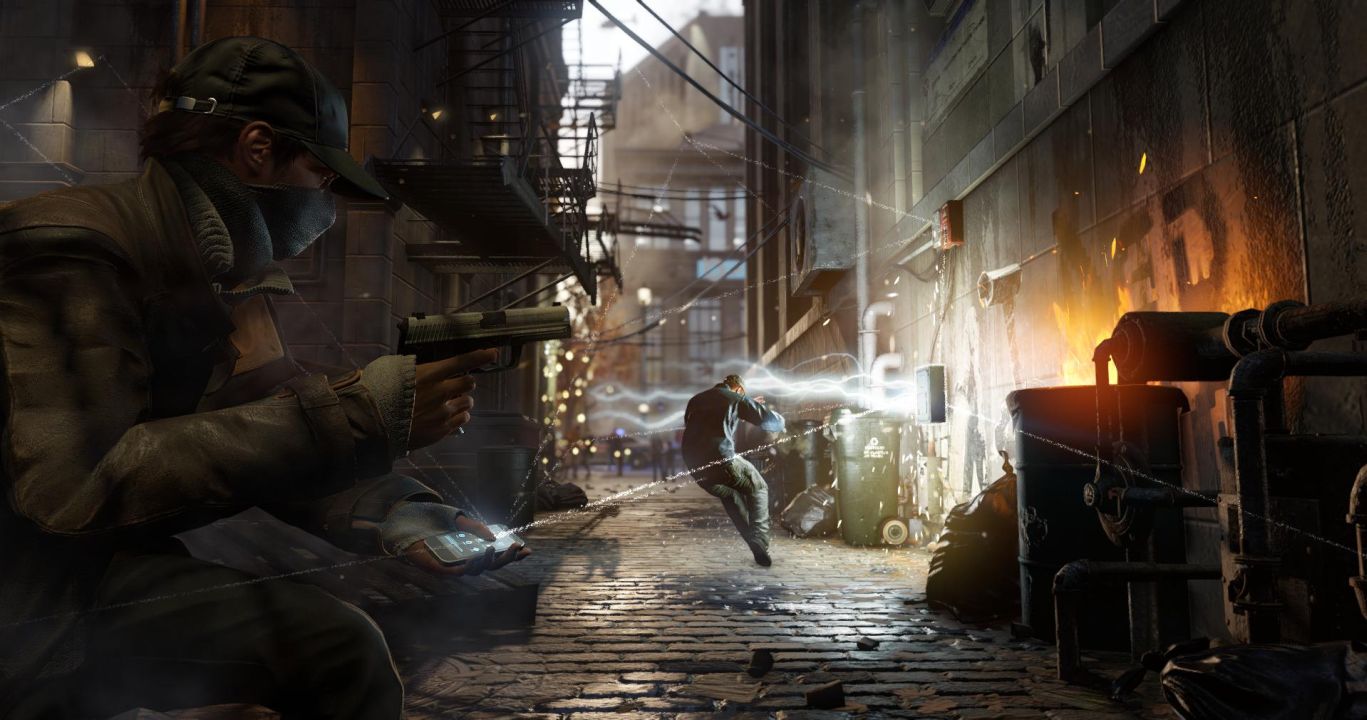
Aiden behaves more along the lines of Sam Fisher than a protagonist from Assassin’s Creed – slow, and methodical rather than an all-out combat veteran. His movements aren’t the quickest and moving cover to cover is easy thanks to a well implemented control scheme. Again much like Sam, Aiden can take out unsuspecting foes with an instant melee takedown, but also cannot survive for very long when taking gunfire. This means most missions can be completed in stealth, a mix of hacking and accidents, or result in a slow and tense cover-based shootout. The choice is of course up to the players.
Watch Dogs differs in its stealth implementation because of Aiden’s ability to hack. The controls are relatively simple. You hold Square to hack into any accessible device in the game – from phones to industrial machinery, to bridges and gates. In a sample scenario, Aiden approaches enemy territory but does not enter it – instead you remotely hack a nearby security camera. From there, the players are able to “jump” from one camera to another – and even to those that are worn by the enemies, or laptop cams sitting on a desk, and so forth. When you see an interactive item either within range of your phone or through a camera, you can hack it. This ability to jump between cameras and different points of view not only allows for better exploration of the environment, but also acts as a puzzle of sorts in some missions where Aiden performs everything remotely. There are also times when hacking minigame makes an appearance, requiring players to supply power to certain points on a grid.
Hacking adds an unprecedented amount of choice to the players. Some missions are actually completed remotely and act more like puzzles, with Aiden hacking from camera to camera until you’re in view of the objective. When Aiden does need to be on location, you could enter the area, carefully scan and tag all enemies by hacking a nearby camera, proceed through and quietly knock out anyone in your way, to reach an objective. You can distract guards from their positions and patrols by setting off car alarms or triggering a forklift, among other actions. For a louder approach, you could cause chaos by triggering explosions around the area and taking out most enemies with accidents, then cleaning up areas with a silenced pistol. The depth and variety of approaches in Watch Dogs mission gameplay is truly impressive, and the missions are very well designed to allow for all choices to be viable.
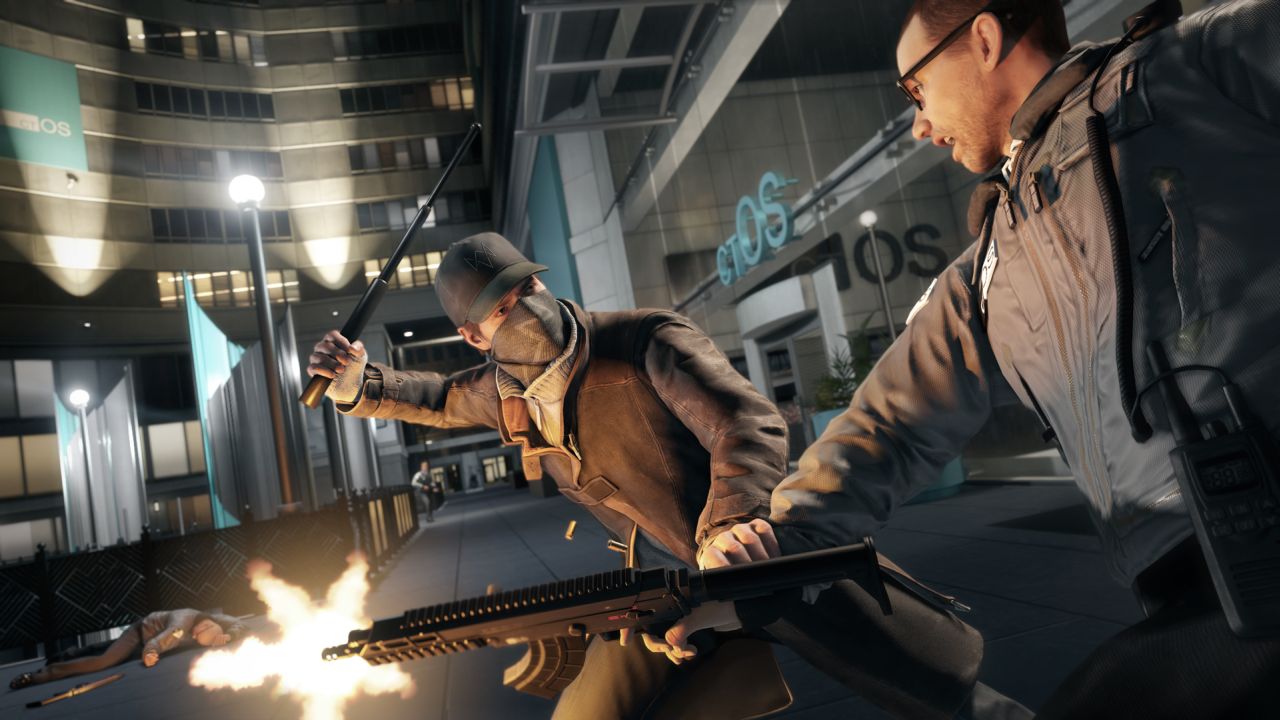
If stealth isn’t your preferred method of conducting business, going in guns blazing is a viable, albeit dangerous approach. Aiden will go down quickly under fire, though you can often erect barricades and hack other items in the envelopment to create cover or new flanking opportunities. Your weapons arsenal consists of throwable items, as well as numerous rifles, submachine guns, and shotguns. Weapons need only to be purchased once, and they remain with you at all times – even in case of death or failing a mission. Because of this, the game is quite generous with cash and you should amass a full arsenal without much trouble. The recoil on rifles is rather difficult to control, but all the weapons sound fantastic and are satisfying to use. If you need extra help, there is a Focus mechanic that temporarily slows down time and lets you pull off well aimed shots.
Most of the missions involve entering of a restricted space, but because of the variety of locations and environmental hacking opportunities, it never gets old. When not on foot, you’re likely going to be driving one of the many types of cars in the game. Sadly, they handle much like Aiden – heavy, slow to turn and tending to drift too much. They understeer and break unevenly. And though after a while you’ll improve, the driving engine is still never quite right. This means you’ll be crashing often, but thankfully the cars seem to bounce off objects and each other, so you’re much more likely to scrape past oncoming traffic than come to a halt.
You’ll find yourself in many pursuits against foes or the police, and the escape works much the same as other open world crime titles. You must first lose line of sight, and then evade the pursuers until you leave the search area. When driving, Aiden has the ability to hack various objects to aid in the escape. You cannot return fire, so you must use the environment – changing lights at an intersection, raising bridges, barricades, and spikes, or even temporarily disabling the helicopters chasing you. You can do it in advance, or wait for a prompt that if timed right will instantly disable one of the foes.
Having said that, escaping is more challenging that it sounds, even at lower heat levels. When going up against the AI on foot and in firefights, they behave predictably – taking cover and shooting on occasion, flanking when possible. When driving however, they are smart, boxing you in, shooting at your car and tires. Most importantly, when they encounter a blocked street or raised bridge, rather than giving up pursuit they will actively drive around the block in order to get ahead and cut off your path. Watch Dogs features some of the best vehicle pursuit AI seen in recent years in open world games.
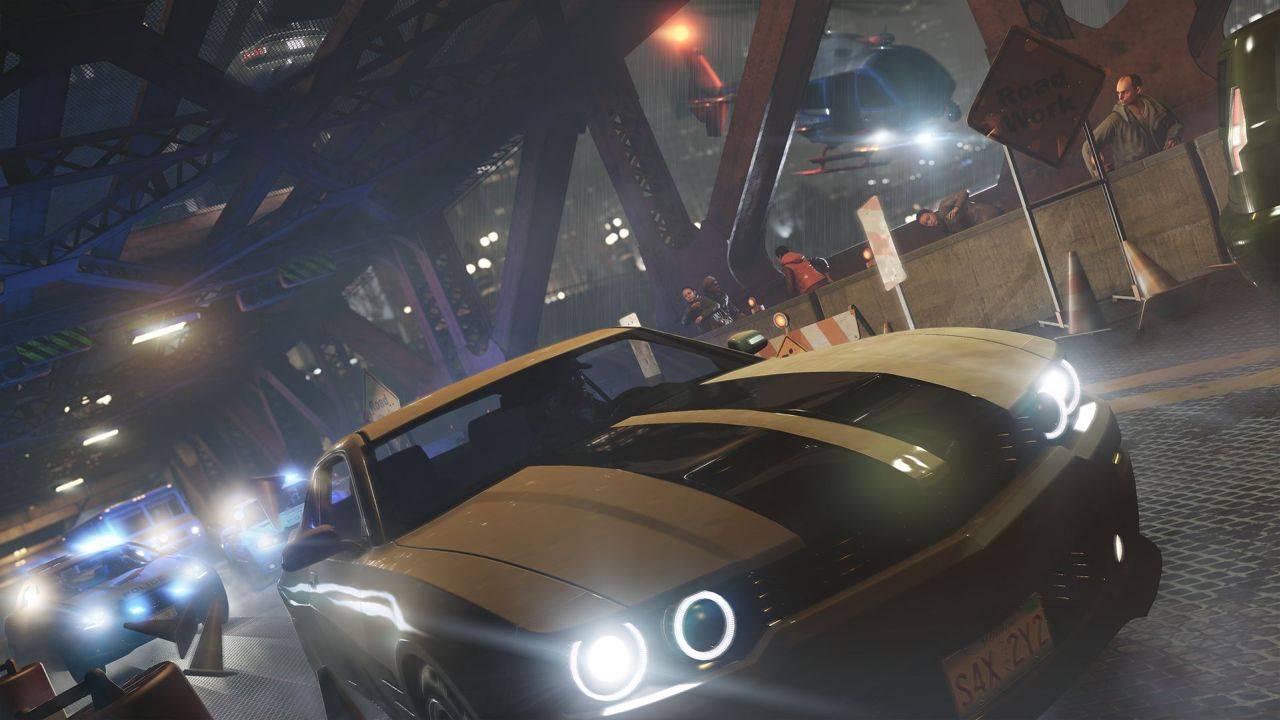
When you’re not playing through the story, there are an absolute ton of side activities to take on. Aside from the usual slew of collectibles to find (new cars and music tracks, etc), minigames to complete (chess puzzles, drinking, betting and more), and even check-in at popular landmark locations, there are also alternate experiences. Aiden can participate in races across the city, shooting missions, and even induced hallucinations – all with special 8-bit graphical effects or simply outlandish settings that were seemingly inspired by Far Cry Blood Dragon. All of these activities are well designed and offer tons of opportunity to divert player attention.
Other activities offer a narrative thread to follow up on, such as human trafficking and weapon imports, but are basically more collectibles to find and puzzles to solve. Or you can participate in stopping street crime, illegal convoys, or clear out gang hideouts. Most missions contribute to your positive reputation within the city, which means citizens are less likely to call the cops if they see you commit a crime or even carjack them. However this reputation meter is slow to move in either direction and unless you take serious time to run civilians over or help with crime, it won’t move very much.
Finishing most activities in the game nets you XP and cash. Much in the same way that the game starts you off with enough skill points to be dangerous, the cash and experience rewards for completing objectives are generous, meaning you can progress quickly and never feel unprepared for a mission. Skill points are earned fast so you can expand your abilities in one of four categories – driving, hacking, crafting items, and combat. The abilities you unlock in each category are self explanatory – from a larger arsenal of hackable items, to faster weapon handling, to better car endurance and so forth. The crafting system lets Aiden create various throwable objects – from distracting radios to EIDs and grenades, or even cause a block-wide power blackout. These are created on the fly with ingredients if you have collected enough, or can simply be purchased at the store.
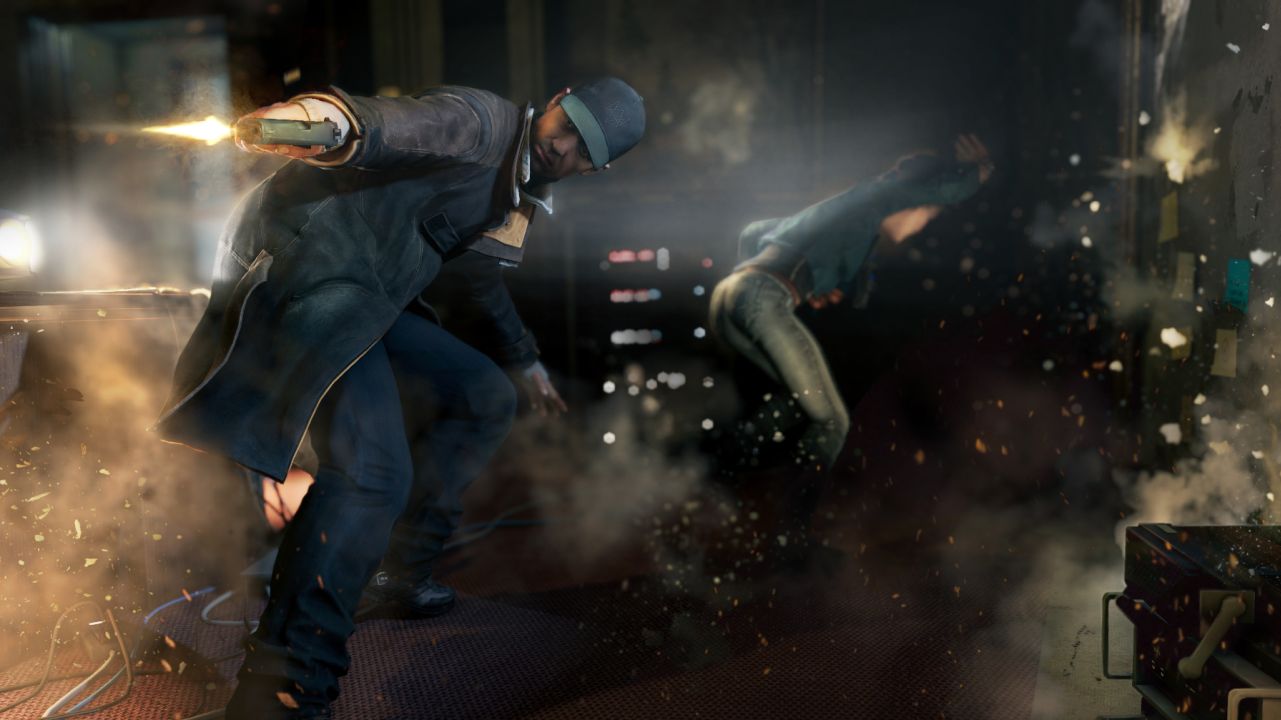
Exploring the city and outlying areas is purely optional, because everything is available to Aiden right from the start of the game. It wouldn’t make sense having to unlock parts of the map that are invisible (like in Assassin’s Creed or Far Cry), however that doesn’t mean there aren’t still towers you need to reach and hack. Doing so reveals all collectibles in the area as well as safehouses for fast travel, so it is purely optional, but yet another puzzle to solve in a city already chock full of content. Plus you’ll get to check out some great vistas and the immense attention to detail, even in the furthest suburbs and nearby towns.
Before you get too far into the storyline, Watch Dogs will setup a player invasion. This is your seamless, abrupt introduction into the online world of the game. The setup is that as long as you’re online, other players can invade your single player experience with a goal to either hack you or tail you. You’ll be notified when this happened, and you must use the profiler to scout the nearby area and ID the invader – they cannot harm you, or their points and progress is lost. Should you succeed, you must kill them before they escape. Even if the objective is not fulfilled, both players will usually be rewarded with Notoriety points.
At any time, you can bring up the online menu and start invading – or the game will also frequently offer sessions to jump into. If you are invading another player, it is less seamless as there is a loading screen to put you into the area of the target. Those are the two 1 vs 1 seamless modes, and given their cat and mouse nature, they are well balanced as Ubisoft has perfected this type of play through the Assassin’s Creed multiplayer.
There are a few more multiplayer activities to partake in – free roam is self-explanatory, with up to 8 players getting together either for coop or adversarial activities; car racing is similarly straightforward. Decryption is somewhat similar to capture the flag, while the special Mobile challenge pits you against players who are using the Watch Dogs App on their tablet device, controlling the cops as you attempt to race through checkpoints. All of the modes work well, with almost no waiting and a far cry from the awful Grand Theft Auto V online launch.
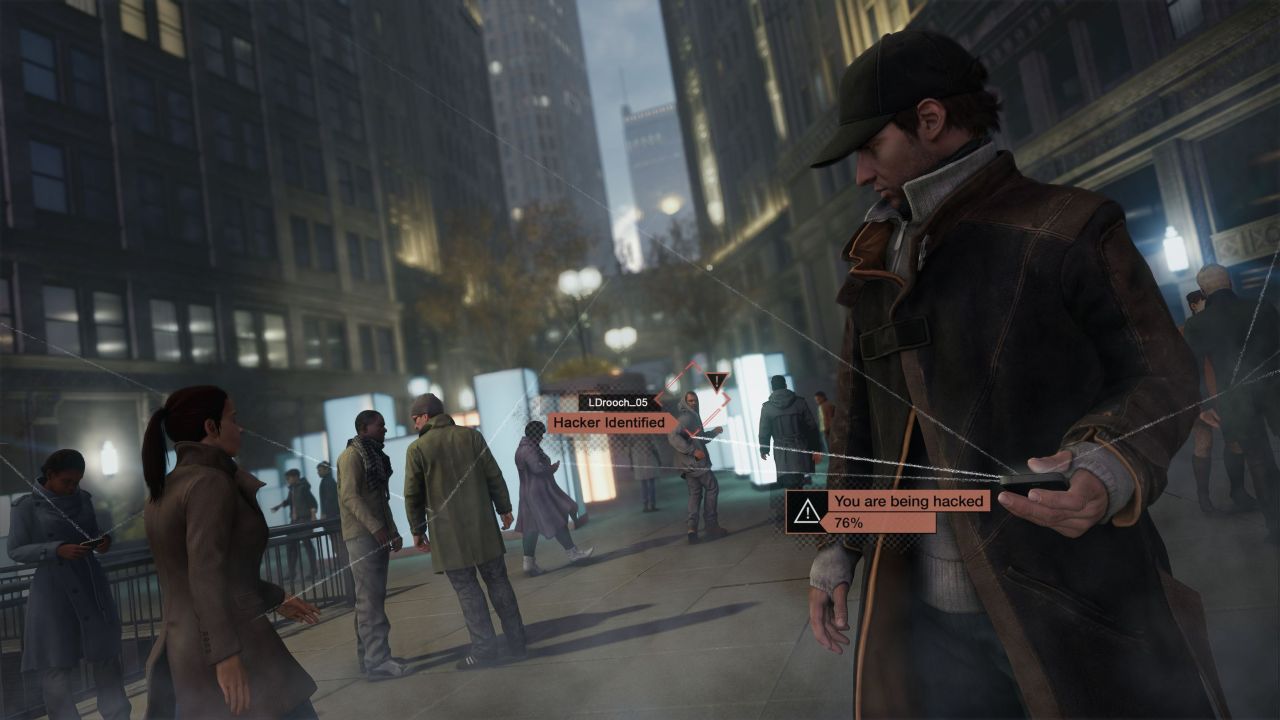
Players get to bring all their skills and abilities from the single player campaign into the online worlds, so your hacking tools are at the ready to put a dent into the competition. However there’s also the notoriety system, whereas you can earn additional boosts to a few of your abilities by participating in online play. These abilities aren’t extremely powerful, and they actually reset if you choose to disable online play and prevent others from invading your Watch Dogs experience. For those that do want to play online – but you happen to lose access to PSN/XBL, Ubisoft servers, or the Internet, rest easy as your notoriety unlock progress does not reset.
All of this hacking makes the GUI of Watch Dogs look rather busy. In addition to the usual visual effects, the actual intractable objects in the world often clash together, along with the NPC profiler, any incoming messages or audio logs, and so forth. It’s actually best to keep your smartphone away when on foot, as the interface becomes far too cluttered. When driving however, your hacking abilities will be automatically ready regardless if you have your phone out.
Your phone also doubles as a useful tool that replaces the menus, containing all info, quickly access your progress tracking, or request a car be delivered. The latter is quick and useful because vehicles spawn nearby instantly, instead of having to wait like in other open world titles. It can also let you play music while travelling on foot – and depending on how many tracks you’ve found and unlocked, the selection of tunes is rather varied. There are no radio stations, and the song selection tries to hit every major genre but that ultimately means it’s just a random tracklist with no personality. Elsewhere in audio design, the sound effects in Watch Dogs are serviceable, from satisfyingly loud gunfire and explosions to uneven volume mix of NPC dialog. The voice acting of the main characters is hit and miss, with Aiden lacking an interesting personality, though at least the writing is actually good enough to support the serious tones of the narrative.
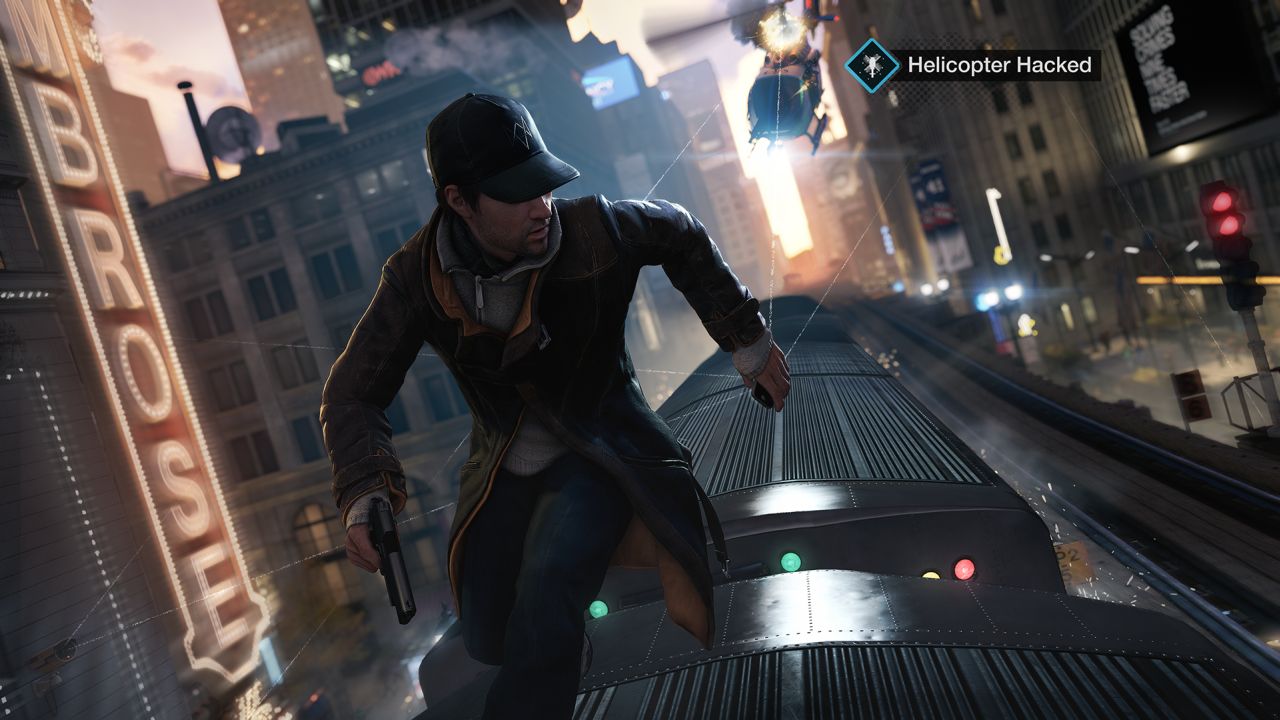
Visually, Watch Dogs is not the best looking PlayStation 4 title, but it’s more than acceptable. The lighting effects are the standout feature, with everything from the sun to the corner street light adding to the atmosphere of Chicago. The textures are high resolution, but are often flat, a clear indication that the game was also created for older generation of consoles. Animations are smooth in action, but cutscenes reveal stiff characters and basic facial animations. There’s also a lack of Anti-Aliasing visible around most objects in the game, from cars to characters, sometimes creating an awkward white outline.
And perhaps most notably, the game sometimes stutters, with the framerate dipping when the game is saving or loading. Thankfully, these occurrences are rare and never in the heated chases or shootouts. There are occasional sound overlap issues, and a few cutscenes were humorously missing a character model, making Aiden talk with himself. When playing online, there is a little bit of lag as well, however it only affects the avatars of other players and not the game world. Good for racing, so you can keep your wheels pointed the right way, but not so great when trying to shoot others.
Watch Dogs may not be the ultra-slick, revolutionary vision that everyone got excited about in 2012. It is still, however, a great open world stealth action title with lots of mission variety, and a ton of things to do. The level of environment interactivity gained through hacking is unmatched, and offers a lot of ways to approach any situation. The city of Chicago is alive, with personal lives of its citizens at your fingertips. Multiplayer modes further boost Ubisoft’s ability to create nerve-wracking, cat and mouse encounters. The game looks and sounds solid on the PlayStation 4, through it takes no unique advantages of the system or the DualShock 4. If you’re looking for a new futuristic setting and an open world to get lost in, Watch Dogs already knows where you live.
